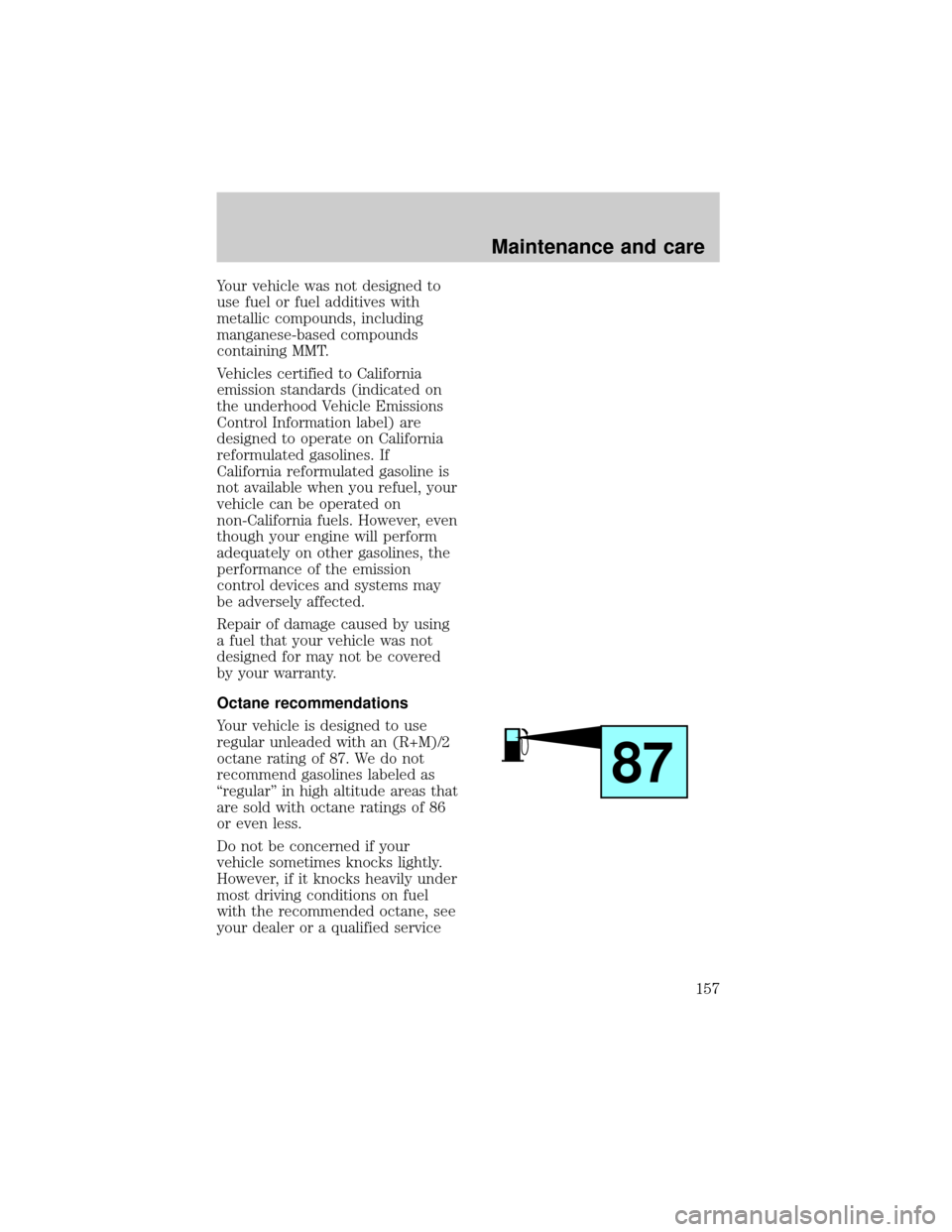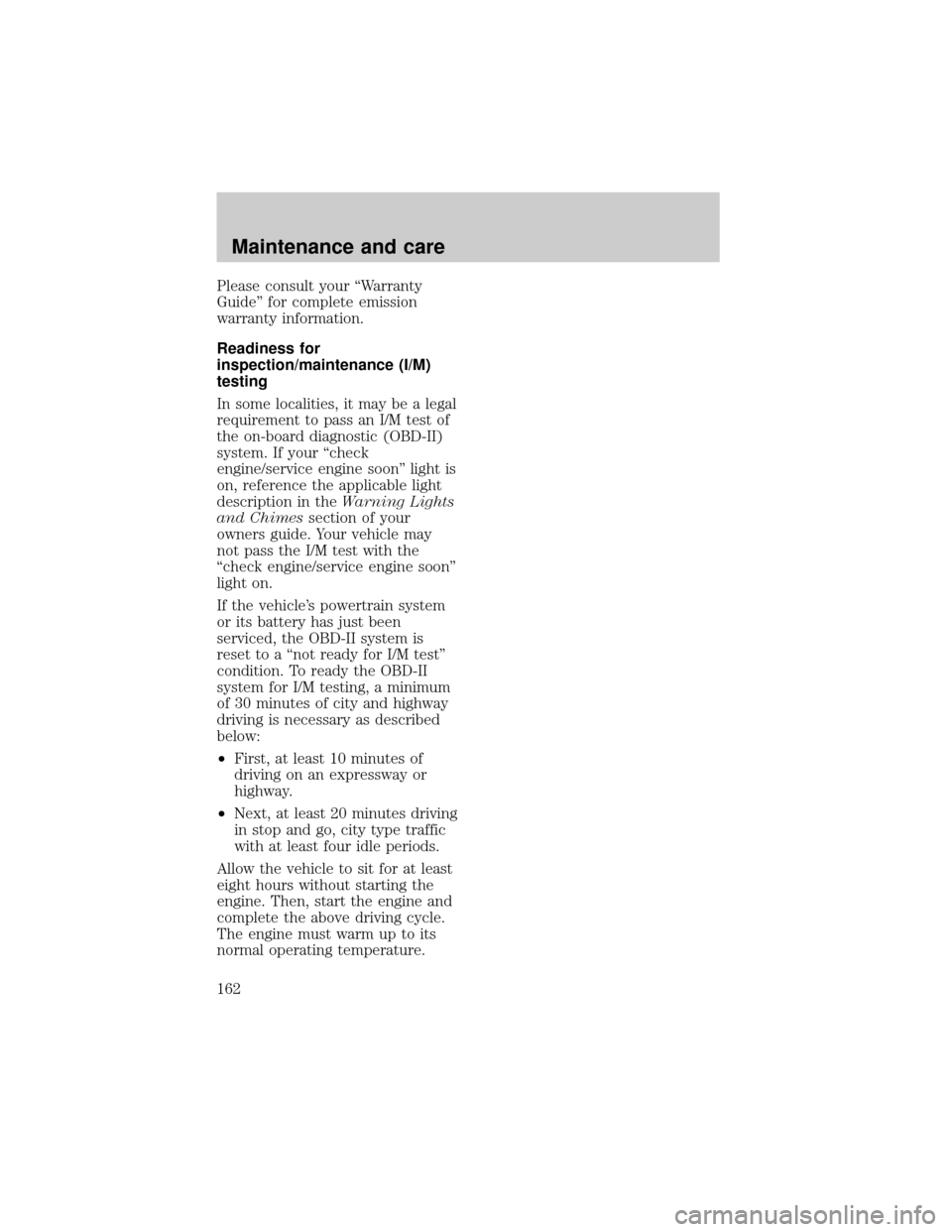Page 137 of 191
CLUTCH FLUID (IF EQUIPPED)
The clutch master cylinder and
brake master cylinder are part of
the same system; both are
refillable through the brake master
cylinder with brake fluid. During
normal operation, the fluid level in
the brake fluid reservoir will rise
slowly. For more information on
brake fluid maintenance, refer to
Brake fluidin this chapter.
WINDSHIELD WASHER FLUID
Checking and adding washer
fluid
Check the washer fluid whenever
you stop for fuel. The reservoir is
highlighted with a
symbol.
If the level is low, add enough fluid
to fill the reservoir. In very cold
weather, do not fill the reservoir all
the way.
Do not put engine coolant
in the container for the
windshield washer fluid.
Maintenance and care
137
Page 157 of 191

Your vehicle was not designed to
use fuel or fuel additives with
metallic compounds, including
manganese-based compounds
containing MMT.
Vehicles certified to California
emission standards (indicated on
the underhood Vehicle Emissions
Control Information label) are
designed to operate on California
reformulated gasolines. If
California reformulated gasoline is
not available when you refuel, your
vehicle can be operated on
non-California fuels. However, even
though your engine will perform
adequately on other gasolines, the
performance of the emission
control devices and systems may
be adversely affected.
Repair of damage caused by using
a fuel that your vehicle was not
designed for may not be covered
by your warranty.
Octane recommendations
Your vehicle is designed to use
regular unleaded with an (R+M)/2
octane rating of 87. We do not
recommend gasolines labeled as
ªregularº in high altitude areas that
are sold with octane ratings of 86
or even less.
Do not be concerned if your
vehicle sometimes knocks lightly.
However, if it knocks heavily under
most driving conditions on fuel
with the recommended octane, see
your dealer or a qualified service
87
Maintenance and care
157
Page 159 of 191
affect on modern powertrain
components.
You may need to crank the engine
several times before the system
starts to pump fuel from the tank
to the engine. If you run out of
fuel, your Service Engine Soon
light may come on. For more
information on the Service Engine
Soon light, refer to the
Instrumentationchapter.
Calculating fuel economy
To accurately calculate your
vehicle's fuel economy:
1. Fill the tank completely and
record the initial odometer
reading.
2. Each time you fill the tank,
record the amount of fuel added
(in liters or gallons).
3. After at least three to five fuel
tank fill-ups, fill the fuel tank and
record the current mileage
reading.
4. Use one of the following
equations to calculate fuel
economy.
Liters used x 1004Total
kilometers traveled
Total miles traveled4Total
gallons used
Keep a record for at least one
month. This will provide an
accurate estimate of the vehicle's
fuel economy.
Maintenance and care
159
Page 161 of 191

Do not park, idle, or drive
your vehicle in dry grass
or other dry ground cover. The
emission system heats up the
engine compartment and exhaust
system, which can start a fire.
Watch for fluid leaks, strange
odors, smoke, loss of oil pressure,
the charging system warning light,
the ªService Engine Soonº light or
the temperature warning light.
These events could indicate that
the emission control system is not
working properly.
If you smell exhaust fumes
of any kind inside your
vehicle, have the dealer inspect
and fix your vehicle immediately.
Do not drive if you smell exhaust
fumes. These fumes are harmful
and could kill you.
Do not make any unauthorized
changes to your vehicle or engine.
By law, vehicle owners and anyone
who manufactures, repairs,
services, sells, leases, trades
vehicles, or supervises a fleet of
vehicles are not permitted to
intentionally remove an emission
control device or prevent it from
working. Information about your
vehicle's emission system is on the
Vehicle Emission Control
Information Decal located on or
near the engine. This decal
identifies engine displacement and
gives some tune up specifications.
Maintenance and care
161
Page 162 of 191

Please consult your ªWarranty
Guideº for complete emission
warranty information.
Readiness for
inspection/maintenance (I/M)
testing
In some localities, it may be a legal
requirement to pass an I/M test of
the on-board diagnostic (OBD-II)
system. If your ªcheck
engine/service engine soonº light is
on, reference the applicable light
description in theWarning Lights
and Chimessection of your
owners guide. Your vehicle may
not pass the I/M test with the
ªcheck engine/service engine soonº
light on.
If the vehicle's powertrain system
or its battery has just been
serviced, the OBD-II system is
reset to a ªnot ready for I/M testº
condition. To ready the OBD-II
system for I/M testing, a minimum
of 30 minutes of city and highway
driving is necessary as described
below:
²First, at least 10 minutes of
driving on an expressway or
highway.
²Next, at least 20 minutes driving
in stop and go, city type traffic
with at least four idle periods.
Allow the vehicle to sit for at least
eight hours without starting the
engine. Then, start the engine and
complete the above driving cycle.
The engine must warm up to its
normal operating temperature.
Maintenance and care
162
Page 163 of 191
Once started, do not turn off the
engine until the above driving
cycle is complete.
EXTERIOR BULBS
It is a good idea to check the
operation of the following lights
frequently:
²Headlamps
²Turn signals
²Foglamps (if equipped)
Coupe
Sedan/wagon
²High-mount brake lamp
²Tail lamps
²Brake lamps
²Backup lamps
²License plate lamp
Maintenance and care
163
Page 166 of 191
3. Remove the protective dust
shield from the housing by turning
the dust shield counterclockwise
(when viewed from the rear).
4. Disconnect the electrical
connector from the bulb by pulling
it straight out.
5. Remove the bulb retaining ring
by rotating it counterclockwise
(when viewed from the rear).
6. Remove the old bulb from its
socket by pulling it straight back
out of the socket. Do not turn the
bulb while removing it.
7. Replace the bulb by pushing a
new one straight in with the bulb's
plastic base facing upward. You
may need to turn the bulb slightly
to align the grooves in the plastic
base with the tabs in the bulb
socket.
8. Slip the bulb retaining ring over
the plastic base and lock the ring
by rotating it clockwise until it
snaps into place.
9. Reconnect the electrical
connector to the bulb.
Maintenance and care
166
Page 172 of 191

Using the right bulbs
Function Trade Number
Front park/turn lamps 3457 NAK
Foglamps (if equipped) 881
Headlamps-aero high and low beam 9007
Rear license plate lamps 168
High-mount brake lamp 921
Backup lamps 3156K
Brake lamps 3157K
Interior overhead lamp 12V/10W
Warning lights 37
Instrument panel gauge 194
Map lamps
For bulb replacement, see a
qualified service technician or your
dealer.
AIMING THE HEADLAMPS
Your vehicle is equipped with a
Vehicle Headlamp Aim Device
(VHAD) on each headlamp. Each
headlamp may be properly aimed
in the vertical (up/down) and the
horizontal (left/right) directions
using your VHAD system. The
headlamps on your vehicle are
properly aimed at the assembly
plant, and vertical and horizontal
indicators of the VHAD system are
calibrated.
A bubble (vertical indicator) that
is not centered between the two
red lines does not necessarily
indicate out-of-aim headlamps. If
your vehicle is not positioned on a
level surface, the slope will be
L
R
UP
DN
Maintenance and care
172